The Hag of Beara

The Hag of Beara stares out to sea.
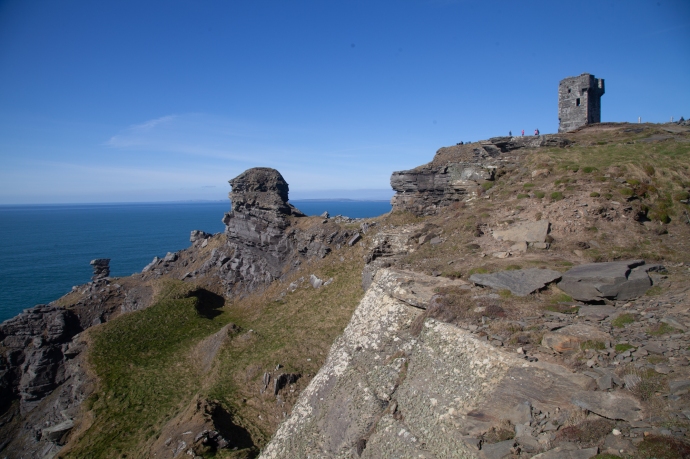
Hag’s Head in Co Clare

The Wailing Woman on Skellig Michael

Hag of Beara

Offerings left on the rock
The Children of Lir

Burial site of the Children of Lir

The Hag of Beara stares out to sea.

Hag’s Head in Co Clare

The Wailing Woman on Skellig Michael

Hag of Beara

Offerings left on the rock

Burial site of the Children of Lir
How would you like a castle in your front yard? Well in Ireland you can have one. They say a man’s home is his castle. Or should that be a man’s castle is in his home.

Just imagine the things you could do with your very own castle. Like, use it to store your ride-on mower or maybe as a cubby-house for the kids.

A home for the ride-on
I came across this one recently. It is just on the outskirts of Liscarroll in Co Cork, which of course has its own Castle that dominates the village. I could not find a name for this one though, so hence I have christened it Castle Gan Ainm, but it is just like the many hundreds of Tower Houses you find all over Ireland.
This one though is literally in the front yard of a farmer’s house.
It is in surprisingly good condition really and many of the features of such houses are preserved. For example there is a chute from what would have been the garderobe (fancy name for medieval toilet – comes from the cry ‘garde robe’ made as a warning to those below, before effluent was unceremoniously tipped onto the street). There are also a few modern additions such as the ‘rooftop garden’ comprising, at this time of the year, gorse in full bloom.


Chute for waste products from the ‘gardebrobe’

A rooftop garden
And of course the resident border collie. The Keeper of the Keep?

The Keeper of the Keep
I had high expectations. An intensive four days of workshops from Caoimhin O Railleagh, Four nights of ‘luxury’ on the shores of Bantry Bay. Meals. All the ingredients were there. Food, fellowship and fiddle.
Would my expectations be met?
I am a bit of a workshop junkie and I am guessing that over the past four years I have had instruction from well over forty different fiddlers while living in Ireland. But Springboard Fiddle Retreat sounded different. Workshops in Ireland generally follow a set pattern, in place since the Willie Clancy Festival started nearly fifty years ago. Bring in a name fiddler, for up to a week. Three hours a day; usually a mixed class of fiddlers or wanna-be’s of all ages and stages. The teaching is based around learning new tunes but there is rarely time for individual instruction or to gain a deeper understanding of the instrument.
But Springboard did not follow this formula. As I said it is residential and there were only a dozen of us. It was a Thursday afternoon and fiddlers from all over Ireland, a couple from Scotland and from the US and a couple of ex-pat Aussies joined others at Linden House on the shores of Bantry Bay in West Cork. The location was hard to find but stunning. I have separately blogged on this little corner of Ireland and the beauty of Glengariff and the surrounding forest, so you can see more HERE.

The calm waters of Bantry Bay at Glengariff
But it wasn’t just the location. The house was purpose designed to accommodate up to 20 people. There were two wings and multiple stories and it made a beautiful architectural statement as it stepped its way down the contours of the land melding into the forest and surrounded by beautifully tended gardens and tall gaunt oaks. There were a number of large living spaces with giant picture windows taking in the vista and plenty of nooks to meet and play fiddle in small groups or withdraw for some quiet time. Everything was provided for a wonderful livable escape.

Linden House. The venue for the retreat

The view from the main living area
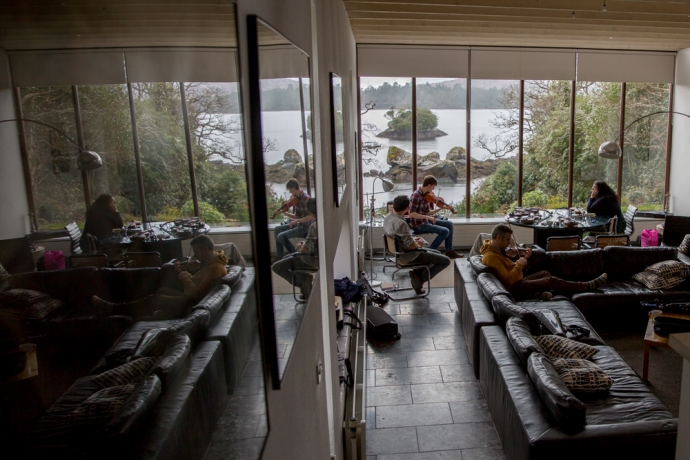
A perfect place to think, read, and play.
Then there was the food. Oh dear. Expectations regarding this weren’t that high when I read it was vegetarian. Nothing against vegetarianism, but I will be honest, I do enjoy the meat-and-three-veg world . But as it turned out absolutely nothing to worry about here. We were incredibly well looked after by chef Jenny and her assistant Anda. The food was truly a marvel. It was prepared with great thought and obvious love. A riot of colour and flavours with some ingredients I have never even heard of and others used in ways you wouldn’t have imagined. All combined with skill and originality. The food was indeed part of what was a total experience We were constantly reminded of the parallels between our explorations with music and the eating experience. Each day one ingredient was chosen as a theme and dishes reflected different and sometimes surprising approaches to the use of this. Just as we would choose a theme for the day on our journey with the fiddle.
Speaking of the fiddle that’s what we were there for, so let me talk about that.
Caoimhin is an accomplished and widely respected traditional Irish fiddler. His collaborations are many and include musicians from wide backgrounds such as piper Mick O’Connor, West Kerry box player, Breandan Begley, sean nos singer Iarla Ó Lionáird, Clare fiddler Martin Hayes and musician/physicist, Dan Trueman. He plays with The Gloaming. His music is rooted in the traditional world of piping and Sliabh Luachra but he has explored Norwegian and Icelandic music, the Hardanger fiddle and plays in various cross tunings. He has always been seeking new ways of voicing the fiddle. As a result he has developed a unique and recognisable playing style.

Instructor Caoimhin O’Railleagh as a snow shower passes through

A reflective moment

The beautifully carved scroll of Caoimhin O’Railleagh’s Hardanger violin

Caoimhin O’Railleagh’s violin. Five strings are just not enough.
Very quickly I realised this fiddle workshop would be different. Caoimhin is a brilliant, relaxed and engaging teacher with an innovative approach. The time available and the ambience allowed plenty of space to explore concepts that were very new, to me at least. We spent little time actually playing. But always new concepts were put in the context of playing traditional music. We spent a day on cross tuning. For myself I stuck with GDGD but others went off in all directions. Indeed people were playing together with wildly different tunings producing surprising outcomes. There were no boundaries. We were encouraged to play tunes we knew opening up new possibilities and to then try our hand at composing melodies.

Caoimhin O’Railleagh makes a point.
Another day we looked at tempo and the concept of expanding and contracting time. We were introduced to the Cyclotron, software by Daniel Trueman, that enables you to vary the space between notes within a tune and ultimately the rhythm and feel. We looked at discovering amazing sounds by exploring the real estate of the fiddle and the bow. We looked at difference tones – notes that only exist in the mind, and we looked at poly-rhythms.


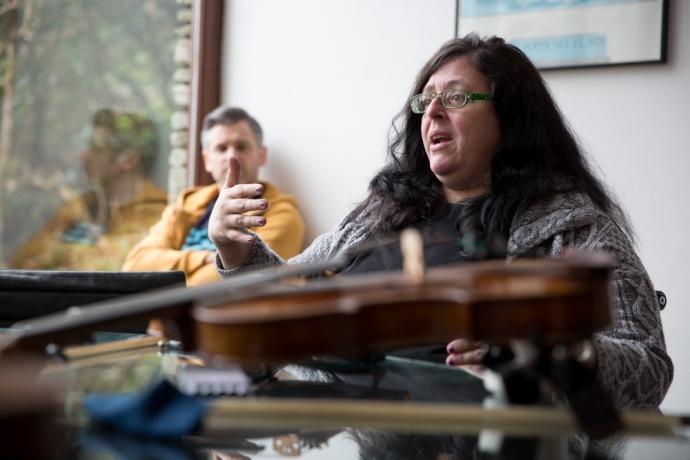
Sounds heavy but it wasn’t. There was were five hours each day of classes, but it went so quickly. And it wasn’t all work.
Afternoons were filled with activities; organised or less-organised. There were ad hoc workshops including ‘dalcroze eurythmics’, yoga, role play games or you could brave the cold (it actually snowed one day) for a swim with the seals. Or you could just go off and practice.

A quiet place to play 1

A quiet place to play 2

A class in ‘dalcroze eurythmics’?

Or time for a dip?

Jotting down some wise words.
The evenings sometimes went in surprising directions; activities including table rugby and games that totally messed with the brain in quite different ways.

Ireland vs the Wallabies in Table Rugby.

A highlight was the Dining in the Dark experience. On this occasion we were treated to a wonderful five course degustation menu prepared and presented by Jenny and Anda, who were the only two ‘sighted’ residents of the house for the night. There were plenty of surprises with our taste buds made keener by the darkness. A butter tasting. Who would have thought? Kale served three ways. A colcannon to die for. A sweet dish which baffled me but turned out to be carrageen pudding and a cheese plate highlighting how good Irish cheese actually is. The meal was interrupted at one point by a spellbinding soundscape of wild fiddle from Coaimhin the sound coming from everywhere as he strolled around the house. Then there was what seemed like an eternity of silence. This was brought to an end by tentative noises made by just one or two at first but then by the full ensemble with whatever came to hand, ultimately turning into an untamed cacophonous symphony of sound and noise of Dada-ist proportions rising out of the darkness.
It is hard to quantify what one gets out of such an experience. I didn’t learn any tunes. There were no sessions in the traditional sense. But I didn’t come for that. What I did get were immeasurable experiences of sharing music and musical thoughts, new ways of looking at timing, rhythm and tone, An insight into new paradigms of playing music and lifetime friends.
A true springboard. Definitely a dive into the unknown.


The Springboard Fiddle Retreat was held on 15th to 19th March 2018. Check their site http://www.westcorkmusic.ie/retreats/springboard for info on 2019.

Glengarriff sits on the upper reaches of Bantry Bay in West Cork. I was lucky enough to spend five wonderful days there last week at a Fiddle Retreat and was able to closely observe the various moods of this sublime waterway. I never actually visited the village of Glenngarriff itself, as my accommodation was tucked away on its own private estate behind the golf course; so private and so quiet that in the time I was there encountered not another soul. other than my fellow residents.
Join me on a walk through this blissful elysium.

Glengarriff waters I

Glengarriff waters II

Glengarriff waters III
Bantry Bay is a drowned river valley (like Sydney Harbour), and its quiet, still protected waters are dotted with steep sided rocky islands sometimes capped with remnant, thick sub-tropical vegetation.

A perched forest I

A perched forest II
The surrounding forest of magnificent oaks birches and conifers has (where the rhododendron hasn’t taken over) a primeval under-story of forest detritus draped with mosses, lichens and ferns, in places forming a vivid green carpet. There is a bubbling stream of crystal clear water that snakes its way down the steep slope into the Bay, cascading over the smoothed rocks and falling into occasional, inviting, pellucid pools.

Moving water

Still water

Forest green I

Forest green II

Forest green III
Azaleas and camellias add colour. This is only March and the rhododendrons can’t be far away from joining in.

Lush sub tropical gardens with flax, azaleas and camelias.
You regularly sight seals cavorting on the shore.

A cavorting seal I

A cavorting seal II
The scene was ever-changing. One moment bathed in brilliant sunshine, then heavy cloud. Frigid weather brought some light flurries of snow flakes drifting to the ground but not settling and then blue skies brought out the singing birds. A Great Tit in an oak tree near the house harmonising with the sweet sounds of the fiddle coming from inside.

Sunshine one moment

Snow the next

The sun brings out the birds. The Great Tit.
Another wonderful hidden gem in beautiful West Cork.
Ireland is full of surprises.
It’s late on a freezing cold March evening and I’m leaving the pretty West Cork town of Bantry on my way back to Clare, after spending the afternoon touring Sheep’s Head. I pick up a hitch-hiker, Sophie, heading to Kealkill about 10 km away. As this is on my way, no problem. She asked to be dropped in the village saying she would get another lift from there. As there are many ways to get where you want to in Ireland, it wasn’t really out of my way so I offered to take her further. Five kilometers on she asks to be dropped at at a lane. Now we were in the middle of nowhere.
On enquiry it turns out she lives “just a little way” down the boreen which she was going to walk. I love the way when you give someone a lift in Ireland they just say “drop me here”, sometimes way short of their destination because they don’t want to inconvenience you further. So 1½ km later we arrive!
Anyway, she was good company and during our short journey I heard all about her family’s move from the UK to 20 remote acres in West Cork, of her daily commute of three hours to Cork city for study and of her menagerie including some more slightly unconventional animals such as emus, a herd of forty pygmy goats and a ‘boer goat’ along with the more conventional dogs, cats, chooks and pigs.

A Boer Goat and some of the Pygmy Goats.

Pygmy Goat
Pygmy goats. I had never heard of them before but it seems are becoming more popular as pets and they are seriously cute. Boer goats come from South Africa where they are usually reared for meat. They are a rather large lump of goat but I can see that some would find them perfect for a pet, in the same way some people get attached to pigs.
But emus?


Emu. Very photogenic
They are a wild flightless bird that roams the outback of Australia. The third largest behind the ostrich and cassowary, and I have certainly never thought of them as pets. Just between you and me they have a bit of a reputation as being dumb. When you encounter their gangly form on outback roads, as you often do, they show remarkable suicidal tendencies running parallel to your car until they find an opportunity to randomly veer directly into your path.
Canadian biologist Louis Lefebvre, when asked to name the world’s dumbest bird responded, “That would be the emu.” Of course Australians reacted negatively to this criticism of its national bird from a country where its police force still rides on horses. Ha, Just kidding. They, however, may not be as dumb as we think. In 1932 the Army were called in to cull 20,000 emus that were destroying crops in Western Australia. Armed with two Lewis guns and 10,000 bullets they were embarrassingly defeated, retreating after killing only a few hundred birds. The birds seemed to have an innate understanding of guerrilla tactics, continually splitting into small groups and chaotically running off in different directions. And their tough hide also proved remarkably resistant to bullets.
They are however insanely curious. I remember encountering a flock. somewhere in the far west of NSW, which I observed from a distance. They didn’t run away; just watched me. I slowly wound down the window and started rustling a packet of chips (crisps, I think you call them). Almost immediately they came over to the point where one was brave enough to try and grab the colourful packet through the window.

Curious?
But hey. Pets? I have never met anyone, even in Australia, who had a pet emu. Just not ever on my radar. Sophie was happy for me to have a look at her Irish versions of the Emu.
They were very friendly and came running over to greet us. I should say friendly to people and seemingly also goats but they hated dogs, chasing them wildly around the paddock.

Emus giving a Jack Russell a hard time.
Darkness arrived and I had to head off but I was left with the slightly discomfiting image of emus, tall and proud surrounded with green rolling green hills and not a eucalypt in sight.

Dromaius novaehollandiae sp Ireland.
Ireland continues to surprise.
Allihies is a very photogenic village near the tip of the Beara Peninsula. I have blogged on it before (click here). There I gave an overview of the whole Beara Peninsula as well as highlighting the extensive history of copper mining in the area, but I didn’t mention the pretty beach near Allihies, which I didn’t visit last time.

The beach at Allihies
Back in the Beara recently, I had a bit more time and found myself on the strand during a break in the bleak weather. This beautiful place has a very interesting back story and an unexpected connection to the mining operations located high up in the hills above the village.
The beach is a surprise. It seems like it shouldn’t be there. The whole coastline here is rugged and rocky and apparently too wild for sand to accumulate. And yet there it is, an extensive thick accumulation of golden sand in a protected inlet.

The inlet at Ballydonegan with the Allihies Beach, the village in the background and the Caha Mountains

A glorious setting and safe.

Sand, water, rocks and sky
A close look however shows all is not what it seems.
The sand is very coarse. It is also very uniform in size and it only comprises fragments of quartz and shale. There are no organic bits or shell fragments as you would expect. In fact is unlike any beach sand I have seen. There are no dunes; just a thick deposit of banded unconsolidated coarse sand. And due to the lack of fines, it is not compacted as might be expected. It is very hard to walk on and especially hard to climb its slopes.

Coarse sand. Lots of quartz and rock fragments

Thick banded sand.
So where did it come from?
This is where the mining comes in. Copper mining took place at Allihies for over 70 years starting in 1813. In its day it was the largest copper production centre in Europe. Allihies was remote and there were no environmental or safety controls and the Mine Captains pretty much did what they liked. So rather than build an expensive dam to contain the tailings they were pumped into the local rivers that eventually found their way to the coast at Ballydonegan. Standard practice then. Environmental vandalism today.

Tailings sand deposited among the rocks near the mouth of the river
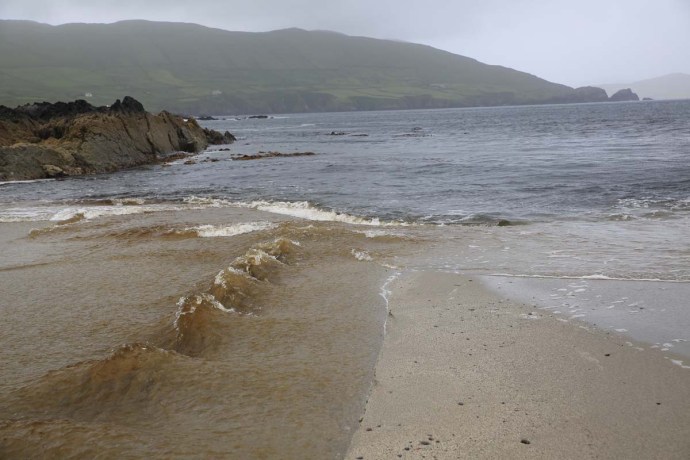
The mouth of the river. Some unusual giant ripples.
So what are tailings? In hard rock mining the rock containing copper minerals is brought to the surface for processing. The total percentage of copper minerals may only be about 2-5% so over 95% of the rock mined must be disposed of. It is crushed and then the copper minerals are separated with the remainder of the rock disposed of. It was lucky that the processing this time didn’t involve toxic chemicals so the tailings was reasonably clean. It accumulated at the mouth of the river and eventually the Atlantic Ocean converted it into a beach. The vast majority of visitors are probably totally unaware that it is man-made.
It is a pretty place. A great safe swimming beach and stunning views. It is ironic though that in the 21st century it is one of the attractions of the area whereas two centuries ago it would have been a major blight on the landscape and that a place of such beauty exists because of man’s indifference and ignorance.

Tranquil and empty. Mid June.

Not quite empty. Holiday makers from the popular adjacent caravan park
I hope my blogs on Ireland aren’t getting too boring. Each time I discover or rediscover a new place I can’t stop scraping up the superlatives. I’ve blogged recently on the magic of Glencolmcille and south west Donegal, on the spirit of Achill Island, on the beauty of Doughmore in West Clare and West Connemara and many places in between. Recently I visited the Beara Peninsula again for the first time in twenty years. And I’m sorry but I have to regale you with more resplendent words yet again.
The Beara Peninula is one of those wonderful headlands that define West Kerry and West Cork, jutting prominently into the Atlantic and adding a whole lot of extra kilometres to the Wild Atlantic Way. Many have well known and evocative connotations. The Iveragh Peninsula, better known as the Dingle Peninsula, and the famous Ring of Kerry are the prime destinations for visitors and do not fail to disappoint. Less well known are the Beara Peninsula, Sheep’s Head and the spectacular Mizen Head.
The attractions of the Beara Peninsula are however becoming better known and I am told by the locals that this summer it was crowded with visitors. I chose to visit in late October. The weather was good (in Irish-speak that translates to ‘no rain’) and it has to be the perfect time. At the western end, the roads are almost deserted and you feel you have this magnificent landscape to yourself.
An obvious draw of this place is that it is more compact than the Ring of Kerry but there is so much variety, so much of interest and so much to fill the shortening autumn days that it was hard to leave.
So what does this little treasure offer? For a start magnificent vistas are around every corner. You can approach from the Northern Road or the Southern Road but my strong recommendation is you find time to do both.






And sometimes you see something that you know could not be replicated anywhere else in the world. The patchwork quilt and stone walls that say Ireland, Ireland, Ireland.



There are a number of mountainous rocky passes. I explored the Caha Pass this time, which links Kenmare with Glengariff. Here there is stunning scenery and four remarkable tunnels (known as Turner’s Rock Tunnels) built in the 1840s when they decided to go through the rock rather than over it. Quite an engineering feat for its day and very unique for road construction as most tunnels in Ireland were built for railways. Indeed the railway construction boom did not start until the 1840s so these tunnels predate any rail tunnel in Ireland. From this impressive road there are craggy mountains, magnificent pasture and grasslands, and sweeping panoramas. Next time I will do the Healy Pass.




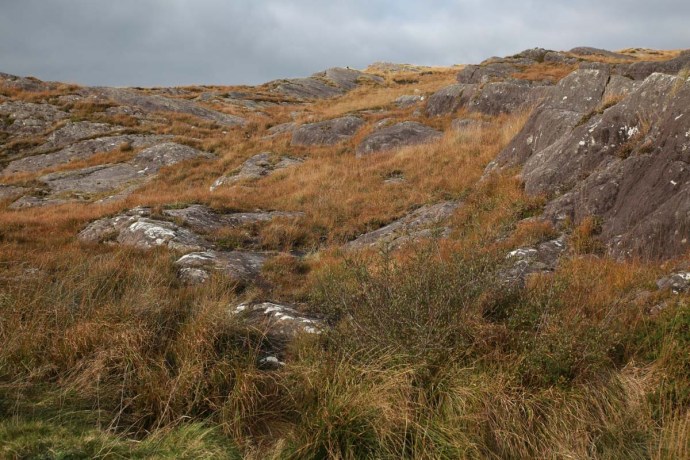
Elsewhere you will see wild, coastal panoramas, verdant forests, jagged islands or houses perched on grassy knolls with staggering views or nestled into rugged rocky cliffs.





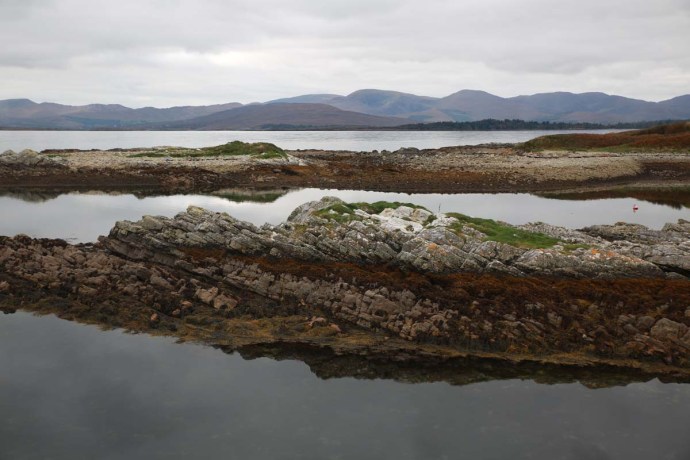


The drive to the end of the Peninsula and Dursey Island is not to be missed. But be prepared for perhaps a little disappointment. Ireland’s only cable car which links the island to the mainland and at this time of the year only runs between 9.30am and 11am was ‘fully booked’ and not operating for transport of people. It was being used for the day by the local farmers to transport hay across the narrow channel. Where else would tourists be turned away, some mind you who had travelled especially, in favour of bales of hay? Only in Ireland. But somehow it didn’t matter, there was so much else to do and it will be there (possibly) next time. You’ve got to admire the ingenuity of the farmers here. I saw an old ‘retired’ cable car in a yard being used as a chook house. Love it. And love the little insect houses thoughtfully provided by one farmer.



Then there is the colourful palette of the charming village of Allihies, which single-handed may be responsible for keeping alive the paint pigment industry in Ireland. Purples, pinks, indigo and every other colour merged harmoniously into the greys, greens and reds of its rocky backdrop.


And towering over the town is the architectural masterpiece of the Engine House of the Mountain Copper Mine built around 1810. Maybe you think masterpiece too strong a word but it is at least the equal from a heritage perspective of the megalithic ruins or the monastic abbeys that populate the tourist guide books. This is the finest example of an historical mine building I have seen in this remarkable condition. It speaks of the confidence and wealth that the mine brought to this remote outpost as it became one of the jewels of European copper mining during its heyday from 1810 to its closure in the 1920s. There are plenty of reminders of the mining period; old shafts and adits, mine workings, two other engine house ruins, stone walls and in places the tell-tale green and blue staining of copper carbonates.

Mountain Mine engine house




Chasing the copper
There is a museum which gives a very good account of the mining story but unfortunately it is a bit expensive which turns some away. All aspects of the story are covered including the geology, mining technology and social impact. As a geologist it was of course fascinating. And even more so for me having met the next generation of miner there, young J and his mum Frances, locals who had come to see if they could find any copper. As it happened I had seen some workings with strong copper on the way up the hill, so I offered to show them and took them there. J’s wide eyed fascination and enthusiasm was enough reward. Maybe I have helped kick start another geologist’s career.


Still on copper, I stopped at Puxley Manor near Castletownbere. Actually the site of the mansion is right near the ruins of Dunboy Castle but more on that later. It would seem that the location is well cursed having witnessed a number of tragedies over the past 4oo+ years.

Puxley Manor around 1910
When I first saw the Puxley mansion it was 20 years ago it was a shell of a ruin. It had been the home of the Puxley family since the 1700s. They pretty much owned the copper mining industry here and ended up fabulously wealthy. As the industry declined so did the Puxley wealth and when his wife died in childbirth Henry Puxley, the last owner, abandoned the castle. Worried that the British Army would take over the abandoned house, the IRA torched it in 1921, destroying it and its contents. The shell was sold at auction in 1927 but remained a forlorn ruin as this photo shows.
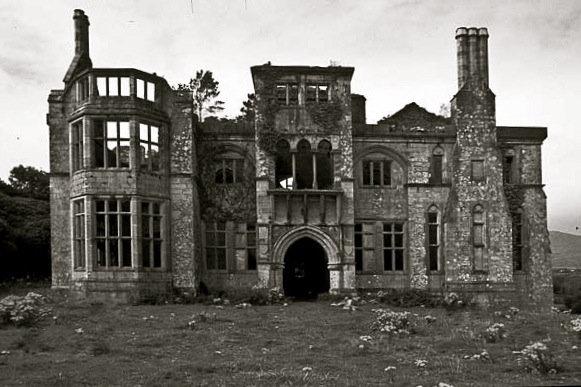
Puxley Manor in the 1990s
This is what it looked like when I saw it in 1996. It was sold to a developer in 1999 and the Celtic Tiger roared. It was to be transformed into a luxury 6-star resort hotel, the only one in Ireland. Massive restoration and conservation work was carried out and all progressed swimmingly with a soft opening in 2007. That was until the money dried up in 2008 with the GFC. By 2010 the project was abandoned and a mesh fence erected. The bats returned but not the visitors. This is how it appears today. The rotting hull of a large boat sits in the harbour as if to reinforce the tragedy. Such a grand vision. The restoration did not however extend to the gate house which stands impressively ruinous.

Puxley Manor. restored but empty

Puxley Manor

Gatehouse. Puxley Manor
I said earlier that Dunboy Castle remains were nearby. This was the ancestral home of Donal Cam O’Sullivan, last of the Gaelic chieftains and a thorn in the side of Elizabeth I during the nine years war which started in 1594. In 1602 she sent a large battalion of troops to destroy O’Sullivan and the 143 men, who tried to defend the castle, could not withstand the British canon. Surrender was not an option after an emissary sent to discuss terms was hung in full view of the defenders. This ultimate fate awaited all those remaining once the British destroyed it and the castle was never lived in again.
The name O’Sullivan however is everywhere on the peninsula. You can’t avoid it.

This little enclave of Cork is truly a gem and you could spend a week here or even a lifetime. There are plenty of stone circles, forts, monuments, holy places (such as the Mass Rock) and extraordinary natural wonders to explore and discover. Oh, and sheep. And there’s Dursey Island, if the cable car is running. And if you’re up for it you can walk it all on the Beara Way.

Ring fort

Mass rock

The black sheep in the flock

There once was a church
The beauty though is not just in the grand vistas but in a host of other details for me that capture the personality of a place. Here are a few photos that speak loudly about the struggle for life for both nature and man.

Abandoned bucket near a well.

Perfect bonsai tree growing wild.

Window treatment

Ingenuity

Maintenance can be a problem

Fantastically fertile for funghi
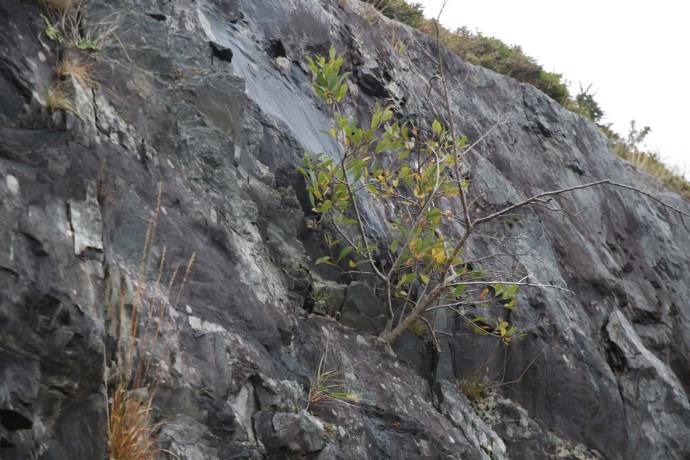
Life hangs on

True love

Faded hope

Was this to avoid the window tax?
So that’s it. I’ll be back and very soon.